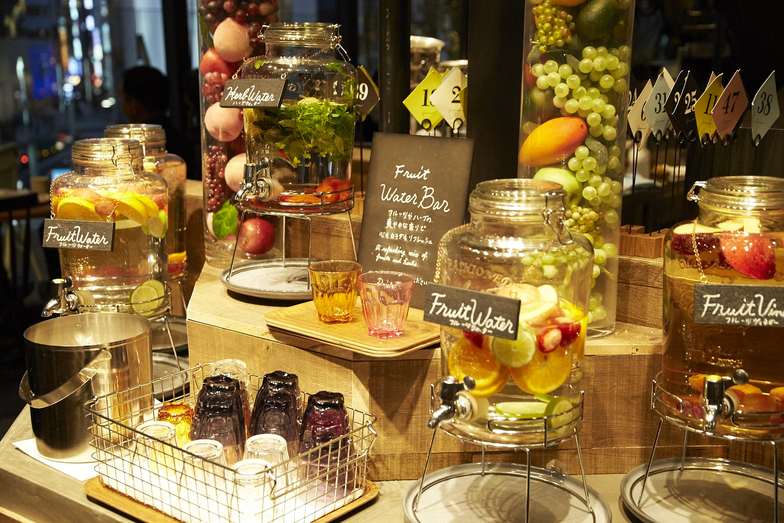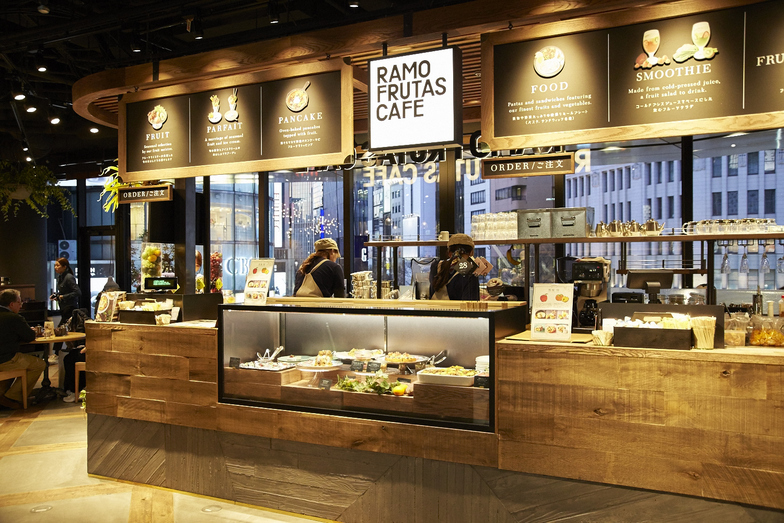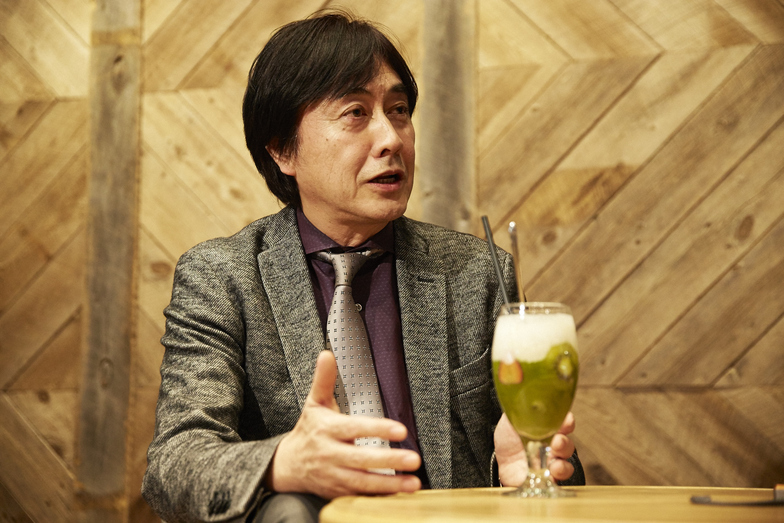On January 4, 2017, Dentsu Group launched Dentsu Live Inc., a new company boasting Japan's largest track record and capabilities in the event and space domain. In this series themed around Dentsu Live Inc.'s "MOMENT OF TRUTH," Dentsu Live Inc. employees and top creative leaders from inside and outside the company will share various visions with readers. For the first installment, Dentsu Live Inc. Vice President Jun Naito conversed with Seiichi Saito of Rhizomatiks and Yoko Shibata of Yoko Shibata Office.
Interview & Editing: Aki Kanahara, Dentsu Live Inc., Creative Unit 2nd Creative Room

(From left) Mr. Naito, Ms. Shibata, Mr. Saito
Photo協力: GINZA PLACE 3F "common ginza"
Live marketing that creates "moments of truth"—the goal of Dentsu Live Inc.
Naito: Dentsu Live Inc. officially launched on January 4th.
Saito & Shibata: Congratulations!
Naito: Thank you. It was formed by merging Dentsu Inc.'s Event & Space Design Bureau with Dentsu Tech's event division, aiming to strengthen our event and space capabilities. What Dentsu Live Inc. champions is live marketing.
Live marketing can be interpreted in various ways. For instance, traditional mass marketing was primarily carried out through television, radio, newspapers, and magazines. After the digital revolution, advertising became less effective relying solely on these channels. Consequently, digital marketing—like what Saito-san does—and the creative expressions utilizing it have gained significant attention in recent years.
Individuals now have access to information across multiple layers, and this information spreads widely, leading to an overflow of information. Paradoxically, in such a situation, people are becoming less easily moved by information alone.
Therefore, the fundamental way to move people remains "human-to-human communication" and "creating real-life encounter spaces." It is through a certain kind of emotional experience, emotional resonance, that various things and actions begin to move. We call this entire process Live Marketing.
Dentsu Live Inc.'s slogan is "MOMENT OF TRUTH." It sounds a bit like a movie title, doesn't it?
Shibata: That slogan is really great, isn't it?

RAMO FRUTAS CAFE, located on the 3rd floor of "
common ginza " within "
GINZA PLACE," which Dentsu Live Inc. is involved in developing and operating.
Cafe tie-ups and event rentals are also available.
When overwhelmed by information and unable to organize it, people form their humanity from only what truly resonates with their hearts.
Naito: Thank you. How do you two feel about this kind of "live marketing"?
Saito: My generation grew up immersed in mass marketing too. But I believe the greatest inventions of the 21st century are how small smartphones and computers have become, and satellites—essentially GPS. Their advancement has profoundly changed our lives.
I once posed this question to a Dentsu Inc. salesperson: "Which has higher cost-effectiveness—spending 8 hours in meetings, or having all the salespeople and us go hand out tissues at Shinbashi Station?" Endless meetings alone are pointless.
Back when Ryzomatiks was just 2 or 3 years old, around 7 or 8 years ago, we were doing digital marketing—essentially web banners. For example, if someone like Mr. Shibata was searching for strawberries, we'd display banners next to them showing things as closely related to strawberries as possible. It was called retargeting.
Mass marketing's blanket advertising approach has weakened. People started saying TV commercials alone weren't effective. So we moved toward using digital tech to personalize information, customizing it for each individual. But over the last two years or so, I've started noticing a pitfall in that approach too.
Shibata: People get used to that kind of approach too, right?
Saito: Exactly. It's like a familiar landscape—it stops feeling fresh. That's why the term "live marketing" really resonates with me now. What matters is what that real experience brings.
No matter how much TV or even VR tries to convey something, with all its sound and effects, ultimately, how the human body resonates with it, actually experiences it, and then spreads that experience—that's the most primitive yet excellent system for advertising that conveys information. In that sense, live marketing feels like the most fitting term right now.
Shibata: That's certainly true. Couldn't we just replace "live" with "real"?
Saito: In the past, events could only be experienced by a very small number of people, but as an intense experience, it stayed with individuals for life. Commercials reach many people, but the experience is shallow. Now, thanks to the development of SNS and personal media, event-like experiences can spread from tens of thousands to millions of people. So I think the methods have changed quite a bit.
Naito: What about you, Shibata?
Shibata: I've been steadily building commercial stores and restaurants, trying to give shape to the visions of passionate chefs or business owners. As this gradually expanded, I started creating entire commercial buildings and even urban development projects. But whether it's a store or a shopping mall, just selling things doesn't resonate at all and doesn't sell. Instead, the impact of an experience that touches the heart, or the effect created by a single rooftop, is tens or hundreds of times greater.
A rooftop can become the symbol of that commercial facility, a device to draw people in, or the focal point of people's impressions of the place. When people are overwhelmed with information and don't know how to process it, they shape their humanity from only what truly resonates with them. That, in turn, becomes the engine that drives them to communicate things to others. When creating a place, if we don't refine it to ensure it has genuine, deep content that truly reaches the heart, it becomes nothing but a facade. It's not just about trends; even if it's inefficient, it's the truth that reaches people's hearts. I believe the answer lies in deepening that.
Investing advertising budgets to create vibrant streets and experiences
Naito: I see. Earlier, Mr. Shibata mentioned places. When we talk about live marketing and moments of truth, the question arises: "So where exactly is that moment of truth?" I'm reminded anew of how crucial place is. Until now, many of our events were held in conventional venues like exhibition halls or hotel banquet rooms. But in recent years, we've started moving beyond those categories. We're beginning to recognize how important it is to consider: what kind of place, what kind of people we target, and what we actually do there.
With less than four years until the Olympics, we'll see an increasing number of visitors from overseas. This raises immediate questions: Where will they stay? Where can companies conduct PR activities? And beyond that, what kind of spaces are needed to introduce Japan itself? These are critical questions we'll face moving forward.
Last year, Mr. Saito and I launched the "Ultra Public Project," aiming to use the entire city as our stage for various experiments. I believe we must seriously tackle the process starting with location selection and what soul we infuse into it. Without this, we cannot create new, inspiring experiences for the future.
Saito: About two years ago, it suddenly struck me: people on commuter trains or walking around are constantly looking down at their smartphones all day. They find the world inside their phones more interesting; the everyday real world seems dull. That's why they inevitably look at their phones. Myself included.
With the advent of Pokémon GO and AR apps, the combination of GPS and smartphones—a brilliant 21st-century invention—has started giving digital content a sense of place. Yet people are still more interested in the virtual world on their phones than in the city itself. I feel like the true appeal of the city hasn't been fully realized yet.
Urban development moves very politically, and of course it expands and contracts in response to the economy. Tokyo especially undergoes rapid metabolism, with land being cleared and buildings constructed at an incredible pace. But with the "Ultra Public Project," we want to look at the city with fresh eyes once more.
Not just Tokyo, but regional areas too—I want to think about how we can make these places feel untouched, like they haven't been worn down yet. Until now, advertising and urban development were completely separate endeavors, right? But in recent years, I feel like the two have started to merge.
Naito: That's definitely the feeling, isn't it?
Saito: With mass marketing and digital marketing, people tend to spend money like water (laughs). For example, they'll pour hundreds of millions of yen or a substantial budget into something, but three months later, it's all been released into the world and vanishes without a trace. If we invested that same advertising budget into the city or the place itself, I think we could easily transform the character of an entire neighborhood.
As Mr. Naito mentioned, it's precisely because a place exists that people want to gather there, or feel compelled to talk about it in concrete terms. They don't just want to see it on a smartphone screen; they want to actually visit the town, see something, and experience it. I think that's what people are seeking, and I believe the towns themselves want to become that kind of place.
*Continued in Part 2








